There is no universal evidence to substantiate that opinion. May be the perception of reality is subjective to every individual. We also need to spell out what exactly is different. It surely would sound different in terms of clarity but it wouldn’t vary from synthetic to natural because of different room acoustics. One would still recognise spouse’s voice from another room regardless. And we would know whether it is reproduced or live.Oh yes. Talking to a person in open ground, in room with high glass treatment and good treated room will sound different. Just that we don't put our audiophile hat in everyday conversations ( which is a good thing). But they all sound different
You are using an out of date browser. It may not display this or other websites correctly.
You should upgrade or use an alternative browser.
You should upgrade or use an alternative browser.
Why there is little focus on acoustics
- Thread starter matbhuvi
- Start date
Passive_audio_enthusiast
Well-Known Member
Yes, but did you loose the direction of the person who spoke to you? Direct wave from a sound source is enough to let us judge the sound if I understand it right. Reflections would enhance the sense of space where the source and we are. Since the direct wave arrived earlier, and was louder than the reflections, the brain can always lock in the direction of the source just with the direct wave's direction. Therefore you likely lost sound loudness here, but loosing the sense of direction of the source is not possible.There they have an anechoic room to measure their drivers. I had the opportunity to visit their factory in 2012 and also visit their anechoic room. We were speaking inside the room for around 15 minutes and we could barely hear the conversation even when speaking loudly.
square_wave
Well-Known Member
Taking the example of an anechoic chamber is an extreme situation in my opinion. Anechoic chambers are only used to get objective measurements of a loudspeaker. The final voicing of the audiophile speaker design is done in a room with a nice balance of treatments that resemble a well balanced living room.I never mentioned any reverberation at all. I only told if 100% of the sound is absorbed, you won't locate the sound source as in an anechoic chamber. You will need to balance how much reflection is ok for your seating position. Typically diffusion at 1st reflection gives perfect balance of direct and reflected sound and hence more preffered.
Directional cues in a recording is included in the recording itself. Just the right amount of reverberation / reflection can reinforce the directional cues in the recording by adding natural spatial information.
The right amount/type of treatment will help make sure the embedded directional information in the recording is conveyed clearly and accurately. Too much treatment will make the system sound like a headphone with the "additional bass feel" you get only with loudspeakers if you sit in the sweet spot.
I have noticed that you hear deeper into the music when the right amount/type of treatment is present. When you start removing the treatment, the sound starts coming forward with a lot of overlap in the cues making it sound artificially livelier and forwards into the room removing the insights into the overall performance.
square_wave
Well-Known Member
I am no expert but i got this from Chat GPT.I used to work in the automotive industry in the US for 20 years. For NVH testing (noise, vibration, harshness) testing, my company had state of the art An echoic chambers maybe 40,000-50,000 sq,ft, wherein we could drive a car/truck in, put it on a cnc controlled platform, shake the crap out of it, to hear where the noise was coming from. If there was no way to hear where the noise was coming from, how would this work? Anyways it is what it is, I think your analogy is not clear. I am no expert in this, I may be wrong.
Cheers,
Sid
- Direct Sound: In an anechoic chamber, you still hear the direct sound coming from the source. This means that directional cues created in the recording or by the positioning of the sound source are preserved.
- Absence of Reflections: The lack of reflections and reverberation means that the sound you hear is incredibly pure and accurate to the source. This can actually make it easier to perceive directional cues without the interference of room acoustics.
- Testing: Anechoic chambers are often used to test speakers and microphones precisely because they provide an environment where directional properties can be measured without the influence of room reflections.
Since I know where the person is standing and my eyes where open my eyes could locate the sound source. Probably my ears couldn't. Most of the time when your ears can't locate the source of sound for whatever reason, you tend to see with your eyes from where the probable sound is coming from. 12 years is quite a lot of time and my visit to IWAI then was not to experiment this effect and hence cannot be conclusive.Yes, but did you loose the direction of the person who spoke to you? Direct wave from a sound source is enough to let us judge the sound if I understand it right. Reflections would enhance the sense of space where the source and we are. Since the direct wave arrived earlier, and was louder than the reflections, the brain can always lock in the direction of the source just with the direct wave's direction. Therefore you likely lost sound loudness here, but loosing the sense of direction of the source is not possible.
Alright!Taking the example of an anechoic chamber is an extreme situation in my opinion. Anechoic chambers are only used to get objective measurements of a loudspeaker. The final voicing of the audiophile speaker design is done in a room with a nice balance of treatments that resemble a well balanced living room.
Directional cues in a recording is included in the recording itself. Just the right amount of reverberation / reflection can reinforce the directional cues in the recording by adding natural spatial information.
The right amount/type of treatment will help make sure the embedded directional information in the recording is conveyed clearly and accurately. Too much treatment will make the system sound like a headphone with the "additional bass feel" you get only with loudspeakers if you sit in the sweet spot.
I have noticed that you hear deeper into the music when the right amount/type of treatment is present. When you start removing the treatment, the sound starts coming forward with a lot of overlap in the cues making it sound artificially livelier and forwards into the room removing the insights into the overall performance.
sachinchavan 15865
Well-Known Member
A question to the experts:
‘Do the designs of the best headphones mimic anechoic chamber or build in reflections and diffusions to mimic real life listening? And why?’
Secondly, what about the design of our pinna? Do the reflections by its designs not affect the sound we listen to? So what happens when we listen to an IEM? Does it mimic these reflections in some way?
Even when we are listening to a baithak at an unamplified venue, aren’t we also listening to some reflections? So, isn’t our ‘normal listening’ a result of similar reflections? I’ve never heard, but assume it might feel weird listening to something without any reflections etc whatsoever.
‘Do the designs of the best headphones mimic anechoic chamber or build in reflections and diffusions to mimic real life listening? And why?’
Secondly, what about the design of our pinna? Do the reflections by its designs not affect the sound we listen to? So what happens when we listen to an IEM? Does it mimic these reflections in some way?
Even when we are listening to a baithak at an unamplified venue, aren’t we also listening to some reflections? So, isn’t our ‘normal listening’ a result of similar reflections? I’ve never heard, but assume it might feel weird listening to something without any reflections etc whatsoever.
Last edited:
The way you hear sounds and decipher the location of the source and whether the source is moving towards you, away from you, direction in which the source is moving depends a lot on the anatomy of the ear and varies from person to person. So if a reviewer is gushing eloquently about some speaker or headphone, don't take it as a gospel truth. Use your own ears. IEMS eliminates the effect of room based reflections, but cannot eliminate the effect of the reflections happening inside the IEM housing. But IEMs have bigger issues than worrying about reflections and other stuff. The small size of the transducers make IEMs subpar for high fidelity audio reproductions if you think high fidelity should include the full frequency range (including the very low frequency range). A high quality IEM can beat headphones in details in the higher frequency range, but not the low end and definitely not sub bass.Secondly, what about the design of our pinna? Do the reflections by its designs not affect the sound we listen to? So what happens when we listen to an IEM? Does it mimic these reflections in some way?
There is a huge difference between baithak and speakers. In a baithak you get the sound to your ears directly from the source and from the reflections. When it comes to speakers, you get the sound (directly and reflected) from the left separately from the sound from the right speakers. The combination of the two sounds (left and right) create an illusion. Imperfections in placement and room acousting helps in breaking the illusion and there goes the quality of the music down the drain.Even when we are listening to a baithak at an unamplified venue, aren’t we also listening to some reflections? So, isn’t our ‘normal listening’ a result of similar reflections? I’ve never heard, but assume it might feel weird listening to something without any reflections etc whatsoever.
Last edited:
unable to attach as the file size is over the limit. Pasting download link.If you don't mind can you post which part of Tooles book mentions this?
You can skip directly to chapter 6 for more insights.
Passive_audio_enthusiast
Well-Known Member
Please post a screenshot of the part. It’s easy to say it’s there in the bookunable to attach as the file size is over the limit. Pasting download link.
You can skip directly to chapter 6 for more insights.
Read and you can find quotePlease post a screenshot of the part. It’s easy to say it’s there in the book
vinothkumar
Well-Known Member
This kinda acoustic treatment costs 1000 times of luxurious GIK acoustics stuffRanjeet Singh’s place is a nice example of an alternative “acoustic treatment”.
This listening space doesn’t resemble a studio but that wall of stuff and organised chaos works to diffuse and absorb those standing waves. Now, this isn’t practical for everyone and none of us might have that collection. Only the select few can afford such a man cave.
There is no universal evidence to substantiate that opinion. May be the perception of reality is subjective to every individual. We also need to spell out what exactly is different. It surely would sound different in terms of clarity but it wouldn’t vary from synthetic to natural because of different room acoustics. One would still recognise spouse’s voice from another room regardless. And we would know whether it is reproduced or live.
May be i didn't write my point clearly. I am not saying that acoustics treatment will convert a speaker in to live music equivalent. All i am saying is, there is incremental benefits with treatment. A simple treatment like placing a plant in first reflection point is way better than having plain wall or glass windows. And that will cost just 2k or less and would be a better upgrade than any cables or interconnects. I am just pushing for that awareness than anything else.
Hope you were able to read the document over the weekend. If not i am pasting the documentation for your reference. I am pasting 6 image files from the text for the context of the discussion. If you are pressed for the time, you can directly look at the last image for an conclusion.Please post a screenshot of the part. It’s easy to say it’s there in the book
Thanks,
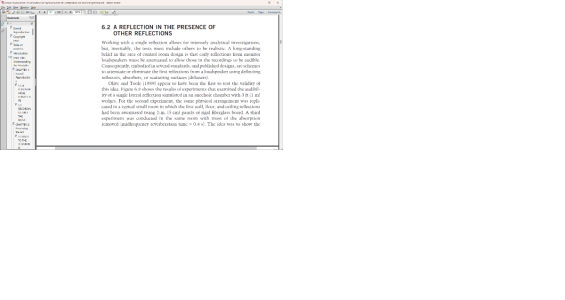
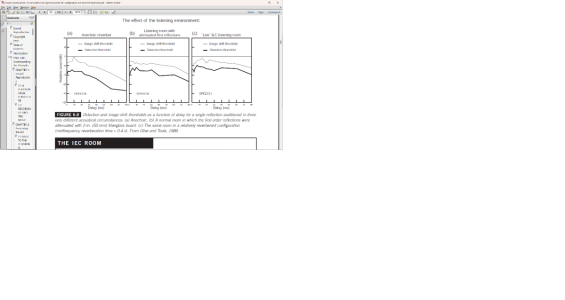
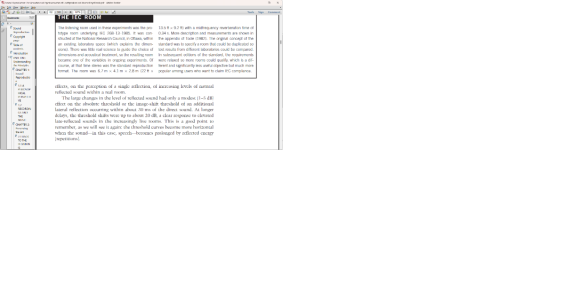
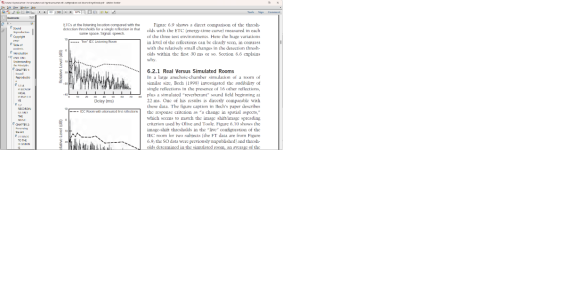
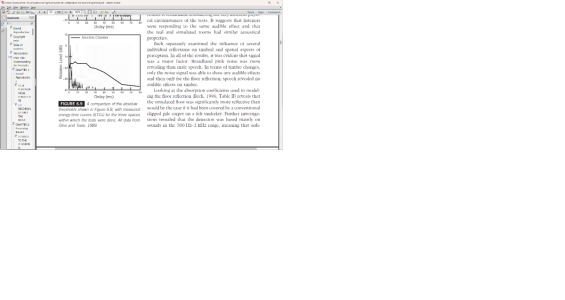
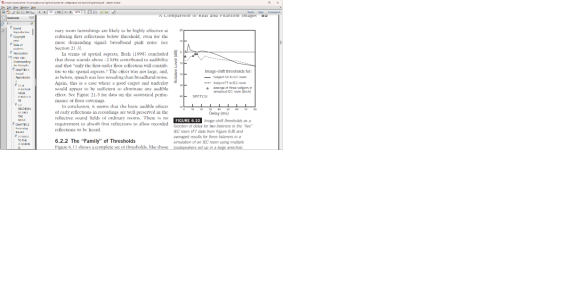
According to Floyd Toole you need not absorb or diffuse the first reflection in a small room as the sound will anyway take the precedence effect and the reflected sound will not be heard as a secondary source if the delayed sound is <30msec. Infact having a moderate to strong first reflection helps in spatial resolution and liveliness in sound.May be i didn't write my point clearly. I am not saying that acoustics treatment will convert a speaker in to live music equivalent. All i am saying is, there is incremental benefits with treatment. A simple treatment like placing a plant in first reflection point is way better than having plain wall or glass windows. And that will cost just 2k or less and would be a better upgrade than any cables or interconnects. I am just pushing for that awareness than anything else.
Early reflection if heavily absorbed can sound muddy in speech and it will be difficult to understand the lyrics properly.
square_wave
Well-Known Member
This dead horse has been beaten to death many times over and over again on many forums with audiophiles preferring one over the other depending on their personal preferences. There is another paper by AES on the subject in 2013. Listening with your music at your preferred volume levels in your own room can actually give you lot more insights, exploration and subsequent decisions.
Most audiophiles prefer diffusors at the first reflection points. I have tried it all. I like diffusers. A bookshelf full of books also works well at these positions. I absolutely dislike flat hard blank walls at the first reflection points especially in a smaller listening room. I currently don't have diffusers because my speakers are in a typical heavily furnished living room and the speakers fire into curtains, bookshelves and sofas.
In a proper rectangular dedicated listening room, where the sitting position and side wall distances can cause first reflections enough to interfere, most people prefer to have something on the wall. Diffusors over absorbers gives you the following benefits.
Wider soundstage: Diffusive side walls can give a wider sound, albeit with less precise imaging as compared to absorbers.
Retained energy: Diffusion helps reflect and spread sound waves more evenly, conserving energy compared to absorption.
Lively room feel: Unlike absorbers, diffusers keep your room lively by scattering sound waves rather than absorbing them.
There are people who prefer to have a panel with more absorption qualities too. Such a setup will give you very precise images. Almost headphone like feel to the mids and highs. I find it less lively.
Most audiophiles prefer diffusors at the first reflection points. I have tried it all. I like diffusers. A bookshelf full of books also works well at these positions. I absolutely dislike flat hard blank walls at the first reflection points especially in a smaller listening room. I currently don't have diffusers because my speakers are in a typical heavily furnished living room and the speakers fire into curtains, bookshelves and sofas.
In a proper rectangular dedicated listening room, where the sitting position and side wall distances can cause first reflections enough to interfere, most people prefer to have something on the wall. Diffusors over absorbers gives you the following benefits.
Wider soundstage: Diffusive side walls can give a wider sound, albeit with less precise imaging as compared to absorbers.
Retained energy: Diffusion helps reflect and spread sound waves more evenly, conserving energy compared to absorption.
Lively room feel: Unlike absorbers, diffusers keep your room lively by scattering sound waves rather than absorbing them.
There are people who prefer to have a panel with more absorption qualities too. Such a setup will give you very precise images. Almost headphone like feel to the mids and highs. I find it less lively.
Last edited:
Small listening rooms having volume less than 1800ft3 cannot diffuse sound effectively as delay time is short. Sofa and soft furnishing can be absorbers. Image shift will change drastically if tried to over treat the first reflection point. You can try this if possible if your first reflection diffuser is removable. Expect more spacious and spatial resolution if done.
Unless the reflective surface is so strong that it replace the source sound itself you need not worry to absorb or diffuse them.
Unless the reflective surface is so strong that it replace the source sound itself you need not worry to absorb or diffuse them.
Passive_audio_enthusiast
Well-Known Member
Unfortunately I was too busy that I saw this now. By the way, which book is this? I went to the book you linked earlier and it has a different index : Also, from the screenshot you showed here, yes it talks about some reflections in the room, but nothing which relates to the conclusion you came to, which were :According to Floyd Toole you need not absorb or diffuse the first reflection in a small room as the sound will anyway take the precedence effect and the reflected sound will not be heard as a secondary source if the delayed sound is <30msec. Infact having a moderate to strong first reflection helps in spatial resolution and liveliness in sound.
Early reflection if heavily absorbed can sound muddy in speech and it will be difficult to understand the lyrics properly.
Hope you were able to read the document over the weekend. If not i am pasting the documentation for your reference. I am pasting 6 image files from the text for the context of the discussion. If you are pressed for the time, you can directly look at the last image for an conclusion.
Thanks,
View attachment 88634
View attachment 88635
View attachment 88636
View attachment 88637
View attachment 88638
View attachment 88639
"If you absorb the first reflection you will loose and NOT gain direction cues." - I don't know where this comes from those screenshots.
"There is zero direction cues on headphones as there is no room in the first place" - I understand where this is coming from. In the Tooles book its explained in a special context.

Now the context: If you listen to a speaker in any environment, say anechoic or in a reflective room, the sound that reaches your ear canal has the HRTF, which is our own individualized sound eq our head and torso features create. A flat sound reaching near gets modified by our body in a unique way, and that modified sound is the reference flat for each of us. This is also a directional cue. This the directional cue which he mentions that would be lost while wearing headphones. However thats not the only directional cue out there. The recording itself can have directional cues, and those things still wont be lost in the absense of HRTF. @sachinchavan 15865 the answere to your question earlier is also here.
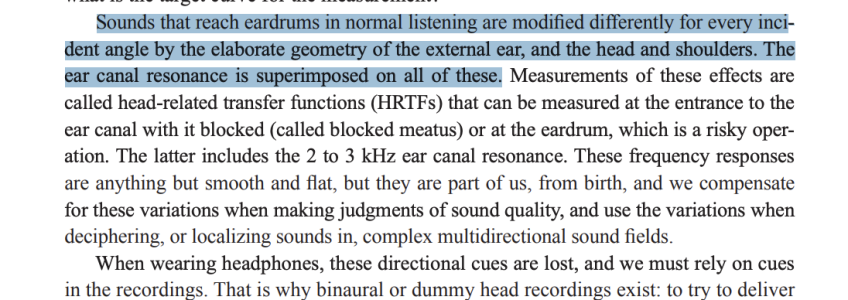
You did not read the concusion on the last image - which I asked you to readUnfortunately I was too busy that I saw this now. By the way, which book is this? I went to the book you linked earlier and it has a different index : Also, from the screenshot you showed here, yes it talks about some reflections in the room, but nothing which relates to the conclusion you came to, which were :
"If you absorb the first reflection you will loose and NOT gain direction cues." - I don't know where this comes from those screenshots.
"There is zero direction cues on headphones as there is no room in the first place" - I understand where this is coming from. In the Tooles book its explained in a special context. View attachment 88640
Now the context: If you listen to a speaker in any environment, say anechoic or in a reflective room, the sound that reaches your ear canal has the HRTF, which is our own individualized sound eq our head and torso features create. A flat sound reaching near gets modified by our body in a unique way, and that modified sound is the reference flat for each of us. This is also a directional cue. This the directional cue which he mentions that would be lost while wearing headphones. However thats not the only directional cue out there. The recording itself can have directional cues, and those things still wont be lost in the absense of HRTF. @sachinchavan 15865 the answere to your question earlier is also here.
View attachment 88641
"In conclusion, it seems that the basic audible effects of early reflections in recordings are well preserved in the reflective sound fields of ordinary rooms. There is no requirement to absorb first reflections to allow recorded reflections to be heard."
square_wave
Well-Known Member
This is just talking about the " basic audible effects of early reflections in recordings " and how they are preserved in the typical reflective fields of ordinary rooms.You did not read the concusion on the last image - which I asked you to read
"In conclusion, it seems that the basic audible effects of early reflections in recordings are well preserved in the reflective sound fields of ordinary rooms. There is no requirement to absorb first reflections to allow recorded reflections to be heard."
As audiophiles, most people are worried about the overall quality of sound and its emotional impact on the listener at the listening position in a listening room. Not just the specific thing being discussed in that conclusion.
At least my comments are coming for personal experience for many years, mostly from WIP listening rooms in exploration stages at friend's homes and once at my home as well.
Buy from India's official online dealer!
Similar threads
- Replies
- 5
- Views
- 8K
- Replies
- 1
- Views
- 785
- Replies
- 0
- Views
- 1K
- Replies
- 27
- Views
- 10K


